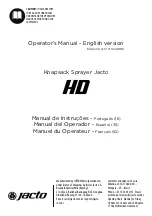
S775 | Issue 3 (H,F) 27/11/18
Original Language Version
© Jack Sealey Limited
Sealey Group, Kempson Way, Suffolk Business Park, Bury St Edmunds, Suffolk. IP32 7AR
01284 757500
01284 703534
www.sealey.co.uk
ENVIRONMENT PROTECTION
Recycle unwanted materials instead of disposing of them as waste. All tools, accessories and packaging should be sorted, taken to
a recycling centre and disposed of in a manner which is compatible with the environment. When the product becomes completely
unserviceable and requires disposal, drain any fluids (if applicable) into approved containers and dispose of the product and fluids
according to local regulations.
Note
: It is our policy to continually improve products and as such we reserve the right to alter data, specifications and component parts without prior notice.
Important
: No Liability is accepted for incorrect use of this product.
Warranty
: Guarantee is 12 months from purchase date, proof of which is required for any claim.
7. MAINTENANCE
7.1 CLEANING
7.1.1.
IT IS VERY IMPORTANT TO ENSURE THAT THE GUN IS CORRECTLY CLEANED AFTER EACH USE
7.1.2.
Disconnect from the air supply before attempting any cleaning, other than flushing, or maintenance.
7.1.3.
Flush the gun thoroughly with solvent and clean the nozzle with solvent and a brush.
DO NOT
immerse/soak the nozzle in
solvent.
8
DO NOT
immerse the entire gun in solvent. This will cause lubricants to dissolve and packing to dissolve or dry out.
7.1.4.
Wipe the outside of the gun with a solvent-dampened rag.
7.1.5.
If you need to clear blocked orifices, be sure to use a probe that is softer than brass.
7.2
Take care when re-assembling. Screw parts hand tight to avoid cross-threading. If a part cannot easily be turned by hand, check
that you have the correct part, or unscrew, realign and try again.
DO NOT
use excessive force when re-assembling.
7.2.1.
Lubricate the gun daily with a light machine oil. Be sure to lubricate the fluid needle packing, air valve packing and trigger pivot point.
7.2.2.
If you change the nozzle size, ensure the complete nozzle set is exchanged. Insert paint nozzle before putting the paint needle in.
8. TROUBLESHOOTING
A faulty spray is usually caused by improper cleaning or dried material around the fluid nozzle tip or in the air cup - use a brush and solvent
to remove. Never use metal instruments to clean the air cup or paint nozzle. These parts are carefully machined and any damage to them
will cause a faulty spray. If either the air cup or paint nozzle is damaged, the part must be replaced before a perfect spay can be obtained.
PROBLEM
POSSIBLE CAUSES
SOLUTION
Dried material in a side port restricts passage of air.
Greater flow of air from the clean side port forces a fan
pattern in the direction of the clogged side.
Dried material around the outside of the fluid nozzle tip
restricts the passage of atomizing air at one point
through the centre opening of the air cup and results in
the pattern shown. This pattern can also be caused by a
loose air cup.
A split spray or one that is heavy at each end of the fan
pattern and weak in the middle is usually caused by too
high an atomization air pressure or by attempting to get
too wide a spray with thin paint.
Tighten, clean or replace parts accordingly.
1. Worn needle packing permits air to get into the fluid
passageway. This results in spitting.
2. Dirt between the paint nozzle seat and body or a loose
paint nozzle will cause the gun to spit.
3. A loose or defective joint between the pot and gun can
cause spitting.
Atomised air flowing through the paint channel to
the bottle. The paint nozzle is not sufficiently tight.
Air nozzle is not completely screwed on.
Material bubbles
or “boils” in paint cup.
Dissolve material in the side ports with solvent,
then blow the gun clean. Do not poke into the
nozzles with metal instruments.
Dried material in a dirty side port restricts passage
of air. Greater flow of air from the cleaner side
port forces a fan pattern in the direction of the
clogged side.
1. Tighten the packing screw or, in severe cases,
replace the packing.
2. Remove the fluid nozzle, clean the back of the
nozzle and the nozzle seat in the gun body
using a rag dampened with solvent.
3. Tighten or replace.
Remove the air cup and wipe off fluid tip using a
rag dampened with solvent. Tighten the air cup.
Paint spray ‘flutters’





















